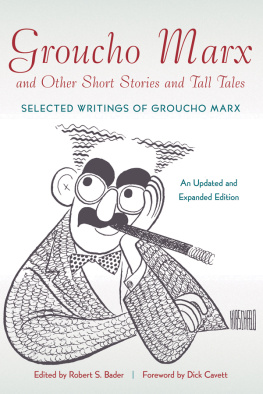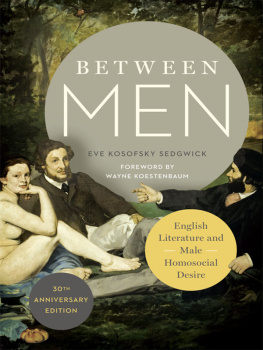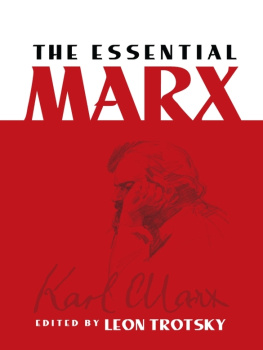The ANATOMY of
HARPO MARX
The publisher gratefully acknowledges the generous support of the Ahmanson Foundation Humanities Endowment Fund of the University of California Press Foundation.
The ANATOMY of
HARPO MARX
WAYNE KOESTENBAUM

University of California Press, one of the most distinguished university presses in the United States, enriches lives around the world by advancing scholarship in the humanities, social sciences, and natural sciences. Its activities are supported by the UC Press Foundation and by philanthropic contributions from individuals and institutions. For more information, visit www.ucpress.edu.
University of California Press
Berkeley and Los Angeles, California
University of California Press, Ltd.
London, England
2012 by The Regents of the University of California
Library of Congress Cataloging-in-Publication Data
Koestenbaum, Wayne.
The anatomy of Harpo Marx / Wayne Koestenbaum.
p. cm.
ISBN 978-0-520-26900-2 (cloth : alk. paper)
ISBN 978-0-520-26901-9 (pbk. : alk. paper)
1. Marx, Harpo, 18881964. 2. Motion picture actors and actressesUnited StatesBiography. 3. ComediansUnited StatesBiography. I. Title.
PN 2287. M 54 K 84 2012
792.7028092dc23
[B]
2011024490
Manufactured in the United States of America
21 20 19 18 17 16 15 14 13 12
10 9 8 7 6 5 4 3 2 1
The paper used in this publication meets the minimum requirements of ANSI/NISO Z 39.48-1992 ( R 1997) (Permanence of Paper).
Any classification you read provokes a desire in you to put yourself into it somewhere: where is your place? At first you think you have found it; but gradually, like a disintegrating statue or an eroding relief, its shape blurs and fades, or better still, like Harpo Marx losing his artificial beard in the glass of water he is drinking out of, you are no longer classifiable. ROLAND BARTHES , Roland Barthes
CONTENTS
ACKNOWLEDGMENTS
My gratitude and affection go to Mary Francis and Ira Silverberg, and to my treasured collaborators in California, especially Rachel Berchten, Nicole Hayward, and Joe Abbott.
Remarkable friends encouraged this adventure: Robert Boyers, Clifford Chase, Harry Dodge, Andy Fitch, Peter Halley, Christian Hawkey, Paul Holdengrber, Myung Mi Kim, Rachel Kushner, Rebecca Mead, Nancy K. Miller, Maggie Nelson, Jacqueline Osherow, Alexandra Penney, George Prochnik, Jonathan Rabinowitz, Lisa Rubinstein, David Shields, Lynne Tillman, and Benjamin Weissman. Sina Najafi kindly published an excerpt, Harpos Bubbles, in Cabinet.
Glenn Mitchells The Marx Brothers Encyclopedia was a trusted guide.
Bruce Hainley understands everything.
Steven Marchetti welcomed Harpo into our household as an intimate, permanent guest.
I dedicate this Anatomy to my mother and father, who knew me before I could speak, and who are familiar with my excesses and indiscretions.
Early Ecstatic Emptiness
I
The Holy Fool Flees Languages Stink Bomb
THE COCOANUTS (1929)
He was attached to sounds and because of his attachment could not let sounds be just sounds. He needed to attach himself to the emptiness, to the silence. JOHN CAGE, Silence
I
ENTRANCE At the studios of Paramount Pictures in Astoria, Long Island, in his first scene, his first major film, 1929, six years before the Third Reich passed the Nuremberg Laws, Harpo enters honking. Honk honk. Pause. Honk honk. Lemming-like, he pursues a woman who doesnt realize that a kook is shadowing her. What does Harpo want? He wants to honk, copy, play, irritate, smash, point, lean, and rest. He wants to find a double, to be useless, to recognize, and to be recognized. He wants to greet the void. He wants to go blank. Or maybe he wants nothing.
PILLOW BOOKS Originally I intended to write a book about Harpos relation to history and literature. A tiny chapter on Harpo and Hegel. A tiny chapter on Harpo and Marx. A tiny chapter on Harpo and Stein. A tiny chapter on Harpo and Hitler.
Then I drafted a novella, The Pillow Book of Harpo Marx. The narrator, Harpo, was a queer Jewish masseur who lived in Variety Springs, New York, and whose grandparents had starred in vaudeville with Sophie Tucker.
Then I decided I didnt want to waste Harpos name on a novella. So I set out to write the book you are now holdinga blow-by-blow annotation of Harpos onscreen actions. My aim? Assemblage. Homage. Imitation. Transcription. Dilation.
Last night I dreamt that my typewriters ribbon expatriated from the machine and curled onto the floor. Dreams are evidence I cant omit from my pillow book.
This opening chapter has the fewest pictures. At first I didnt realize how pleasurable it was to interrupt the movie and seize proof that Harpo was god-like, exemplary, in danger of vanishing if I didnt capture him. I wont go back now and resee The Cocoanuts and grab more pictures; I wont doctor my experimental anatomization of Harpos anti-melancholy body, whose materiality suffuses me with physical contentment, as if I were rocking the infant universe to sleep. When I first fell in love with Harpo, it wasnt, however, his contentment that struck me; I was moved by his hyperkinesis. Other actors handled plot doldrums, while, in the corner, Harpo, unregarded, unspeaking, busied himself with rapid oscillations of head, eye, and hand, self-pleasuring vibrations that sometimes struck sparks in other players, though, mostly, Harpos butterfly gyrations woke no one else to his centrality. I, as viewer, was responsible for granting him primacy; and I could do so only by slowing him down and giving words to these muscular mutations, these gestures of mouth-opening and wrist-bending that were, on the surface, merely funny but, below the surface, were uncannily empty. The idiosyncrasyHarpos nod, or cavern-mouth, or mica-eyesappeared fleeting and subverbal; and I developed a need to convince strangers that Harpos hyperkinetic emptiness had metaphysical dimensions.
CONCENTRATION, ABSTRACTION, SERIALITY Harpo is the silent brother. Could he really talk? Yes, but never onscreen. Later, Ill explain why.
The Marx Brothers had a stage career (vaudeville, Broadway) before their act immigrated to Hollywood; I will limit my attentions to Harpos film embodiment.
Watching his screen adventures, I dont laugh; I concentrate. Concentration is a sadly dwindling cultural resource; opportunities to pay attention even going overboard and fastening monomaniacally to a single object deserve advocacy.
Art, whether visual or literary, may choose to operate in serial fashion, composing its tricks by lining up similarly timed or similarly spaced modules. In Harpos performances, one gag, or incremental piece of comic business, follows another. His gestures obey a mysterious nonlogic of mere adjacency. The schticks fragments stack up like cubes or buttonsimproprietys rosary-beads. His performances, like the oceans, are abstract. We observe the ebb, but we dont expect an explanation.
Behaving as a serial artist, Harpo lines up his selfs pieces, one by one, in a row: he gathers comic bits into a transparent assemblage, hieratic as Marcel Duchamps The Bride Stripped Bare by Her Bachelors, Even, but without didactic baggage. The seeming continuity of Harpos performances disguises their origin in separable flashes of comic perception. Walter Benjamin described the art of Charlie Chaplin in similar terms: Each single movement he makes is composed of a succession of staccato bits of movement. In a different context, the psychoanalyst Melanie Klein, attuned to pieces, theorized an egos tendency to be in bits.







